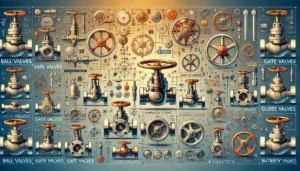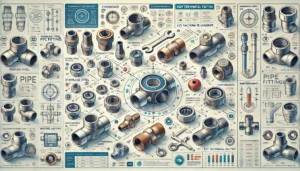Just like pipes and valves, industrial flanges are also equipment parts of any piping system. They function as links between valves, pumps, and other tools. Flanges also enable smooth fitting and removal of piping systems for repairs, inspections, and alterations to be conducted. Usually the rings are sealed with bolts, and gaskets prevent leakage. It is extremely important to comprehend the different kinds of flanges so that the proper one can be chosen for any given system.
1. Weld Neck Flanges
Sometimes referred to as high neck or tapered hub flanges, weld neck flanges are used for the most resistant critical connections between the pipe and the valve. Because of their design, weld neck flanges are some of the best designed flanges in terms of stress. Since welded necks are attached to pipes, they are excellent at keeping the stress and turbulence brought on by high temperatures and pressure at bay. These kinds of flanges are ideal for oil and gas and petrochemical industries as well as for power generation.
2. Slip-On Flanges
Slip-on flanges are meant to slip on a pipe; thus, they have a flange face that extends from the pipe end by a sufficient distance to allow a weld bead on the inner diameter. This feature makes alignment and welding simpler, which is why slip-on flanges are used for low pressure ranges. They are frequently utilized in situations where the piping diameter is common and the pressure levels are not particularly high. They can be installed easily and quickly; therefore, slip-on flanges are widely accepted in many industries.
3. Socket Weld Flanges
Socket weld flanges have a recessed region (socket) to accommodate the pipe end and make it possible to fit the pipe and perform fillet welding. This joint does not separate when exposed to pressure or when there are temperature changes, which makes socket weld flanges ideal for small-bore piping systems and equipment with medium pressure and temperature levels. They are used often in the chemical, power, and water industries.
4. Blind Flanges
Blind flanges are discs which are solid in shape, and these discs are utilized to seal gaps on pipes or containers. Their solid form is beneficial in scenarios where expansion or repairs are needed in the future. Blind flanges can also be used as inspection covers which close inspection holes. Blind flanges, along with their varying pressure ratings and materials, are designed to achieve sealing off pipes permanently or temporarily at the end. They are indeed useful for closing systems where high pressure is put in place.
5. Lap Joint Flanges
Lap joint flanges consist of a flat face flange and a separate backing flange. Along with the flat face flange is an additional secondary flange that serves different functions such as alignment and support. Lap joint flanges are highly preferred in places which frequently need to be taken apart. They are ideal for applications where the pipe material is pricey since the backing lap joint can be made using a cheaper material. Also, these lap joint flanges are common in systems for pipes which are required to be moved into specific positions for alignment.
6. Threaded Flanges
These types of flanges have threads on the inside which makes it easier to secure it with pipes. Because there is no welding needed, threaded flanges can be used in systems where welding is impractical. They are used frequently in small bore piping systems, as well as in other systems where the use of welding is prohibited due to the risk of fire. In addition to flameproof materials, threaded flanges are made of different materials and pressure ratings to match the specific application.
7. Long Welding Neck Flanges
Long welding neck flanges have an increased neck length which provides a firm and sturdy welding connection with a pipe system. These types of flanges are used in different industries including piping works and other industries. Long welding neck flanges are common in gas, oil, and petroleum industries because they are capable of high-stress conditions and connecting extensive pipeage systems. The extended neck provides additional efficiency and effectiveness for the connection which makes it suitable for critical applications.
8. Compact Flanges
Compact flanges balance weight, size, and seal performance. Often, they are used in high-performance subsea oil or gas applications where there are high temperatures and pressure involved. Different applications can use different sizes and compact flanges’ pressure rating, enabling them to be multiversal. Compact Flanges outperform traditional flanges in being lightweight, small, and durable without sacrificing on sealing performance.
9. Vacuum Flanges
Vacuum flanges are an essential component that connects a vacuum chamber, vacuum tubings or even a vacuum pump in industrial or scientific settings. These flanges are engineered to preserve the vacuum environment without any leakages. Like KF, ISO, and CF (ConFlat) a number of standards are available for vacuum flanges having very specific features and applications. Other than the vacuum level, size and component compatibility also determine the selection of the vacuum flange.
10. Flare Fittings
Flare fittings are used in connecting pipes and tubes by flaring the end of the pipe and screwing it to a fitting that also has a flare. Flare fittings are designed in a way that ensures a strong connection that is also leak proof. This makes flare fittings ideal for high pressure systems. These fittings are widely employed in hydraulic systems, pneumatic systems, refrigeration, and air conditioning. Flare fittings also come in different sizes and materials for different purposes.
Conclusion
As with all industrial flanges, these types of flanges are necessary parts of piping systems because they allow for quick and tight, and leak-free connections between pipes and other accessories. The right type of flange must be chosen to achieve safe and operable, effective, and enduring piping systems. Considerations such as pressure and temperature, the nature of the materials, and the particular details of the application needs are very important in selecting a flange. With the knowledge of the different flanges and their uses, engineers and designers are able make decisions that enhance the performance and dependability of the system.










